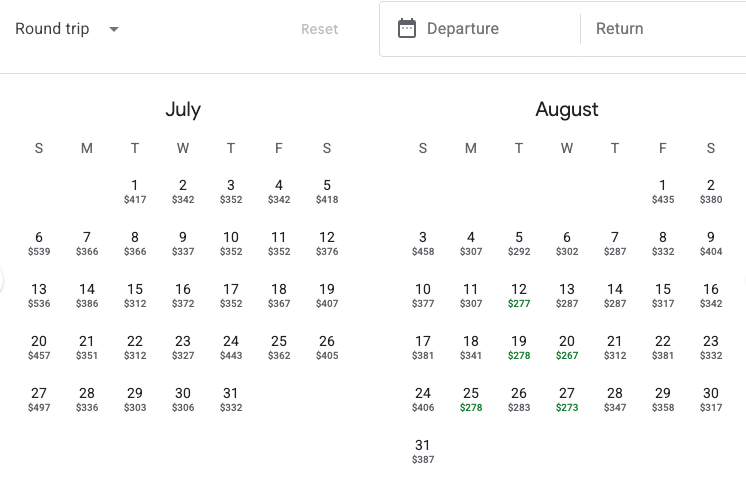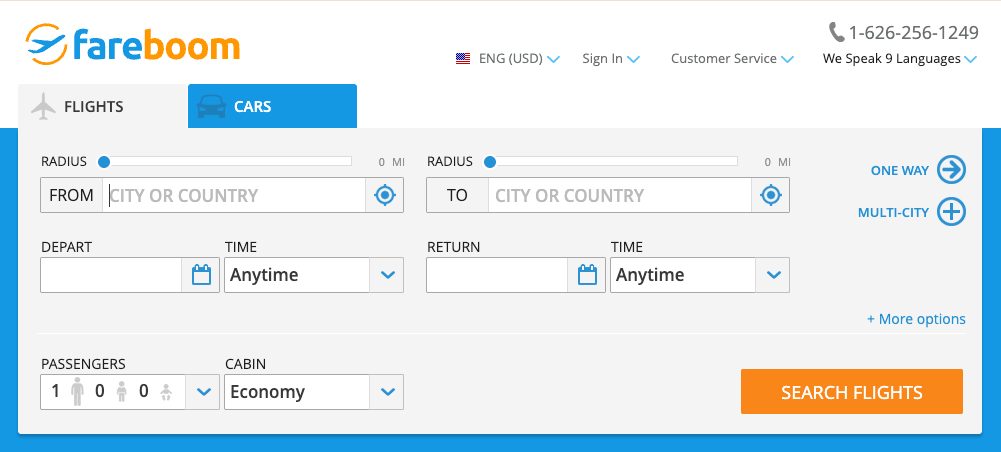Finding cheap flights can be easy if you know how to use fare calendars. These tools let you compare flight prices across multiple dates, helping you quickly identify the cheapest days to travel. Here’s how to save money using fare calendars:
- What are Fare Calendars? Visual tools that display flight prices for an entire month (or more) at a glance. Examples include Southwest Airlines’ Low Fare Calendar, Google Flights’ Date Grid, and FareBoom’s Fare Calendar.
- Why They Work: Flexibility is key. Midweek flights or off-peak travel dates often cost less. Fare calendars make it simple to adjust your plans and save.
- How to Use Them: Enter your departure and destination, select a wide date range, and compare fares across days and months. Look for color-coded cheapest dates (often green).
- Extra Tip: Pair fare calendars with price alerts (e.g., Google Flights or Dollar Flight Club) to track price drops and snag deals fast.

How to Access and Use Fare Calendars
Fare calendars are a handy tool for spotting the best flight deals. While each airline or booking platform has its unique spin on the concept, the main goal is the same: to give you a clear, visual snapshot of ticket prices over multiple days. Here’s a closer look at how some popular fare calendars work.
Using Southwest Airlines Low Fare Calendar
Southwest Airlines offers one of the easiest fare calendars to navigate. You can find it right on their homepage under the “Low Fare Calendar” link or access it through their regular flight search.
Simply input your departure and arrival cities, select the number of passengers, and choose whether your trip is one-way or round-trip. Instead of locking in specific dates, you’ll see a full month’s worth of fares at a glance. Prices for each day are displayed, with the lowest fares highlighted – typically in green for the best deals. Higher-priced days appear in other colors, making it simple to spot savings.
Want to compare prices across months? Use the arrow buttons to move forward or backward. Once you find a date that works, click on it to see flight options and finalize your choice.
Using FareBoom’s Fare Calendar
FareBoom’s fare calendar adds a few extra features to the mix. After entering your departure and destination cities, you’ll see a grid showing the lowest fares for each day of the month. Like Southwest, it uses color coding – green for the cheapest options and red for pricier days.
One standout feature is its ability to show price trends over several months. This makes it easier to plan ahead and identify not just the cheapest days in a month but also the most affordable months for your travel. You can tweak your search settings anytime, whether it’s changing the number of passengers or switching between one-way and round-trip options. Once you’ve found the ideal date, click to explore available flights.
Using Google Flights Calendar and Date Grid
Google Flights offers two powerful tools for flexible date searches: the calendar view and the date grid. Start by clicking the calendar icon to see a month’s worth of fares. The cheapest options are highlighted in green, and you can use the arrows to scroll through months and observe price changes.
The date grid takes it a step further by providing a detailed comparison of fares for trips of varying lengths. This is especially helpful for round trips, as it shows how altering your departure or return date can impact the overall cost. Green highlights in the grid point out cheaper alternatives to your current selection, making it easy to adjust your plans.
Both tools let you quickly identify the best times to fly and how prices shift over time. For example, you might discover that leaving a day earlier or staying an extra day could save you money. With these insights, you can fine-tune your travel dates to match your budget and preferences.

Step-by-Step Guide to Finding the Cheapest Dates
Scoring the lowest airfares takes more than just searching your usual travel dates. It’s all about being strategic and flexible with your plans to uncover the best savings.
Expand Your Airports and Date Ranges
Start by widening your search to include multiple departure airports and a broader range of dates. If you’re flying out of a major city like New York, don’t limit yourself to just one airport – check nearby options too. Sometimes, a short drive to a different airport can save you a significant amount on your ticket.
When it comes to dates, aim for the widest range possible. Many booking platforms let you search an entire month, giving you a clear view of how prices change over time. This approach can help you spot the cheapest options at a glance.
Being flexible with both your departure location and travel dates is a powerful way to uncover hidden deals. Even small changes can lead to noticeable savings.
Compare Prices Across Days and Months
Once you’ve set flexible search parameters, take the time to compare fares across different days and months. Look for patterns – flights on weekdays are often cheaper than those on weekends, and seasonal trends can also impact prices.
Use fare calendars to explore how prices fluctuate over time. Shifting your travel plans by just a few days or weeks could unlock better rates. For example, traveling during off-peak seasons or mid-week can often result in lower fares.
Visual tools, like fare calendars, make it easier to identify the best deals quickly.
Adjust Your Trip Length for Lower Costs
After zeroing in on potential travel dates, experiment with your trip length to see if it affects pricing. For round-trip flights, even a slight change in the duration of your stay can impact the overall cost. Try shortening or extending your trip by a day or two to see if it makes a difference.
For international travel or longer trips, adjusting your return date within your flexible window can reveal significant price differences. Sometimes, staying an extra day – or coming back a day earlier – can lead to surprising savings.
Keep track of which combinations of dates and trip lengths offer the best fares. This will help you weigh your options and make an informed decision when finalizing your booking.

Setting Alerts and Getting the Best Deals
After using fare calendars to pinpoint low prices, setting up alerts is the next step to ensure you don’t miss a great deal. These alerts keep you in the loop about price drops in real time, giving you the edge to book cheaper flights.
Setting Up Price Alerts
Price alerts are a no-brainer if you want to track fare changes without constantly refreshing booking websites. They monitor specific routes and dates, sending you notifications as soon as prices drop, so you can act fast.
The sooner you set up alerts – even if your travel plans are still tentative – the better. Early alerts let you spot trends, helping you figure out when a deal is genuinely worth grabbing.
For broader coverage, set up alerts for multiple airports near both your departure and destination cities. This is especially useful in metro areas with several airport options, as prices can vary significantly between them. Pairing these alerts with fare calendars can help fine-tune your strategy for scoring the best price.
Getting More Deals with Dollar Flight Club
If you’re looking to go beyond basic fare alerts, Dollar Flight Club offers a more advanced way to find discounted flights. Unlike standard alerts that track specific routes, this service actively hunts for deals – mistake fares, flash sales, and other limited-time offers – and delivers them straight to your inbox.
Dollar Flight Club lets you customize alerts based on your preferred local airports and dream destinations. It’s available in three membership tiers:
| Plan | Price | Deal Frequency | Coverage | Special Features |
|---|---|---|---|---|
| Basic | Free | 1–3 weekly deals | Domestic economy flights | 1 departure airport |
| Premium | $69/year | Daily deals | Domestic & international flights | 4 airports, mistake fares |
| Premium+ | $99/year | Daily deals | All classes, including business | SMS alerts, partner perks |
The Premium+ membership stands out with SMS alerts, which are especially handy for time-sensitive deals. Mistake fares and flash sales can disappear within hours, so getting a text notification ensures you don’t miss out, even if you’re not checking your email.
By combining email and SMS notifications, Dollar Flight Club creates a system that helps you catch deals as soon as they pop up. Unlike some services that bombard you with endless offers, this one focuses on delivering carefully curated deals that are worth your attention.
To get the most out of Dollar Flight Club, use it alongside fare calendars. When you receive a deal alert, check if adjusting your travel dates by a day or two could unlock an even lower fare for the same route.

Pros and Cons of Fare Calendars
Advantages and Drawbacks
Once you’ve mastered how to use fare calendars, it’s worth taking a closer look at their strengths and shortcomings. These tools are a cornerstone of flexible flight booking strategies, but they’re not without their flaws. Knowing both the benefits and limitations can help you make the most of them when hunting for cheaper flights.
One of the biggest perks of fare calendars is their ability to display cost-saving opportunities at a glance. Instead of tediously searching day by day, you can view an entire month’s fares and quickly identify the cheapest travel dates. This makes it easier to shift your plans to match the most budget-friendly options. Plus, fare calendars can highlight pricing trends, giving you insight into the best times to book.
But fare calendars aren’t perfect. A common frustration is that the lowest fares shown might not actually be available when you’re ready to book. Often, these tools display the cheapest fare for a date, but that price might apply to flights at inconvenient times, basic economy tickets with strict restrictions, or seats that are already limited.
| Advantages | Drawbacks |
|---|---|
| Easily compare fares across an entire month | Limited to specific airlines or routes |
| Adjust travel dates to save money | May not reflect real-time seat availability |
| Spot pricing trends for smarter booking decisions | Lowest fares may come with inconvenient flight times |
| Some platforms offer price drop notifications | Basic fares often have restrictions |
| May exclude budget or international airlines |
Another drawback is that many fare calendars are tied to specific airlines or routes. For example, Southwest’s Low Fare Calendar only includes flights operated by Southwest, leaving out potential deals from other airlines. Similarly, some platforms exclude budget carriers or international airlines, which could offer better prices for your trip.
Real-time accuracy is another issue. Fares displayed on a calendar can become outdated quickly, especially during peak travel seasons when prices change frequently. This can lead to disappointment if the advertised low price is no longer available by the time you try to book. To avoid this, it’s crucial to act fast when you spot a good deal.
To get the most out of fare calendars, be prepared to move quickly and keep realistic expectations. Remember, the lowest fares often come with trade-offs, such as inconvenient flight times or limited seating. These tools are most effective when you’re flexible with your travel plans and treat them as a starting point rather than a guarantee of exact pricing.
When combined with other resources – like Dollar Flight Club’s curated deals or price alerts – fare calendars can play a valuable role in a broader strategy for finding cheaper flights. They’re not perfect, but they’re a great tool for travelers willing to adapt and plan strategically.

Conclusion
Fare calendars have revolutionized the way we book flights, making it easier than ever to find the cheapest travel dates. Tools like Southwest Airlines’ Low Fare Calendar, FareBoom’s fare calendar, and Google Flights’ date grid help you zero in on the most budget-friendly days to fly, offering significant savings on your next trip.
The key to unlocking these savings lies in flexibility and smart planning. By comparing prices over a wide range of dates and adjusting your trip length, you can uncover the best deals. However, remember that the lowest fares often come with compromises, such as less convenient flight times or restrictions tied to basic economy tickets. With a bit of strategy, though, these trade-offs can be managed effectively.
Fare calendars are just the beginning. Pairing them with other money-saving tools can stretch your travel budget even further. For instance, services like Dollar Flight Club send out email and SMS alerts for discounts of up to 90% on domestic and international flights. These alerts also include exclusive deals, travel perks, and discounts from leading travel brands.
By combining fare calendars with deal alerts, you can create a well-rounded approach to finding cheap flights. Use fare calendars to identify trends and flexible travel dates, and let deal alerts help you snag mistake fares or limited-time offers that might not show up in regular searches.
Whether you’re planning a quick weekend escape or a longer adventure, this two-pronged strategy can make all the difference. Start with fare calendars to chart out cost-effective travel dates, then rely on alerts to catch last-minute savings opportunities. Stay flexible and ready to act, and you’ll be well on your way to booking your next trip for less.
FAQs
How can I make sure the fares I see on fare calendars are still available when I book?
To make sure the fares you spot on fare calendars are still available when you’re ready to book, keep these strategies in mind:
- Set up price alerts: Use tools like Dollar Flight Club to get notifications when prices drop, so you can jump on deals before they disappear.
- Book in advance: For domestic flights, aim to book 1–3 months before your trip. For international travel, the sweet spot is 3–5 months ahead. Booking early helps secure the prices you see.
- Be flexible with your dates: Fare calendars often highlight cheaper flights for midweek travel. Shifting your plans by a day or two can lead to significant savings.
These tips can help you grab the fares you find before they change.
How can I find cheaper flights if my travel dates are fixed?
If your travel dates are locked in, there’s still room to save big on flights with tools like Dollar Flight Club. This service keeps you in the loop by sending email and SMS alerts for discounted fares, potentially slashing up to 90% off the cost of domestic and international flights.
Membership also comes with extra perks. You’ll gain access to exclusive deals, travel benefits, and discounts from leading travel brands, stretching your travel budget further – even when your dates are set in stone.
How can I use fare calendars with other tools to save more on flights?
To get the most bang for your buck, pair fare calendars with tools like price tracking and alert features. For example, set up price alerts to receive notifications when ticket prices drop, and use fare calendars to compare costs over a range of dates.
Being flexible can make a big difference – try searching for flights on different days of the week or during less busy travel seasons. You can also take it a step further by combining these strategies with airline reward programs or credit card points. These small tweaks can add up to big savings on your next adventure!










